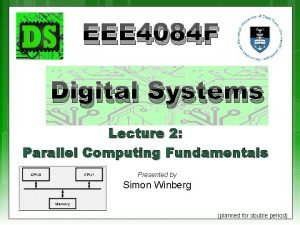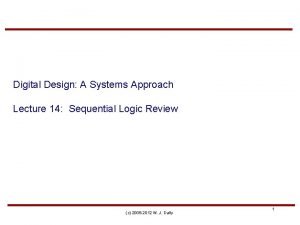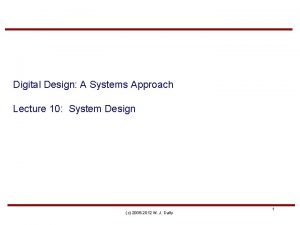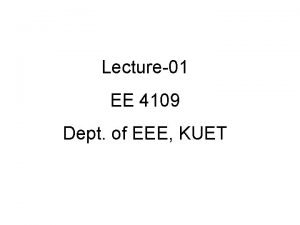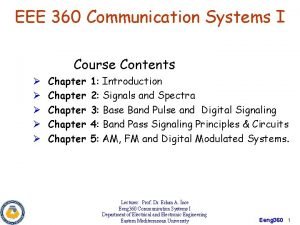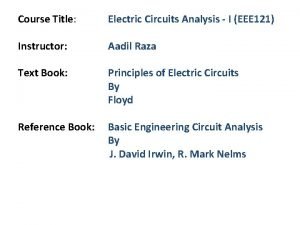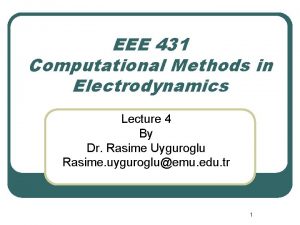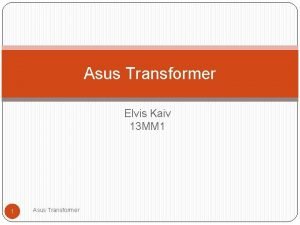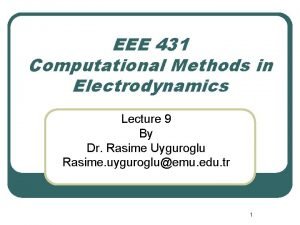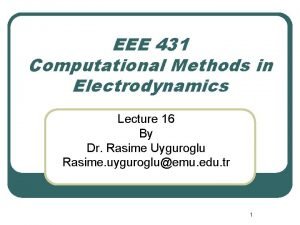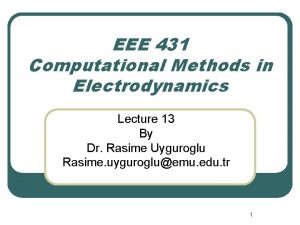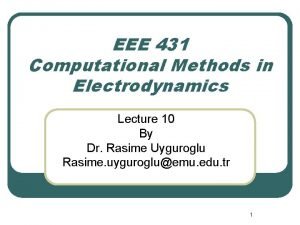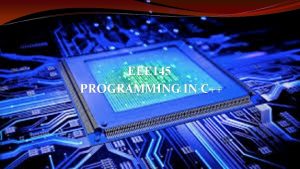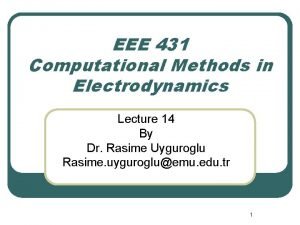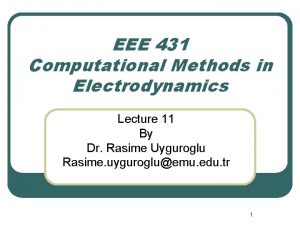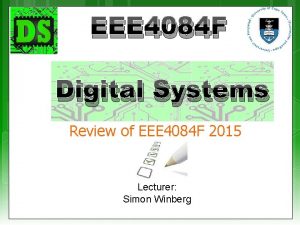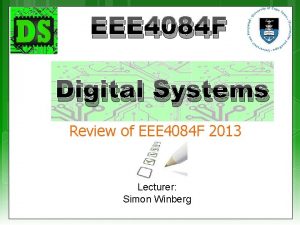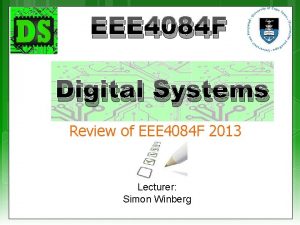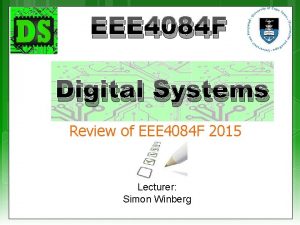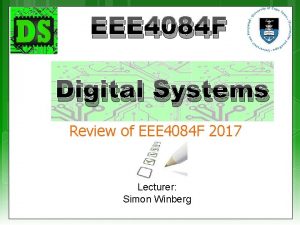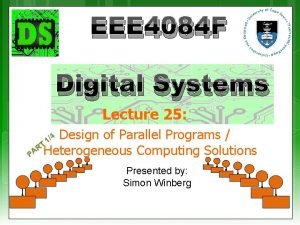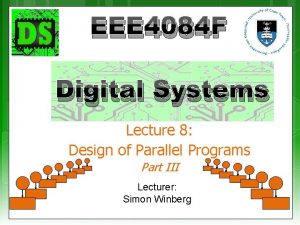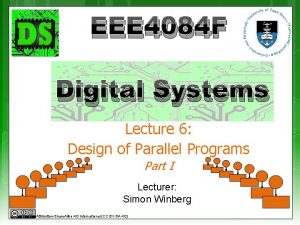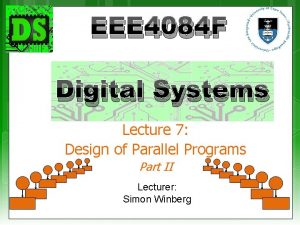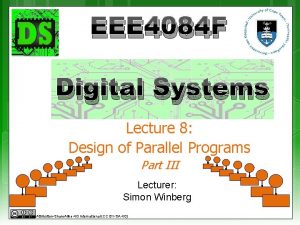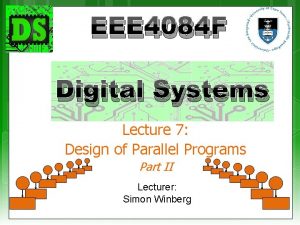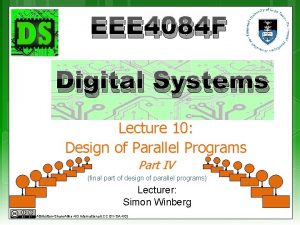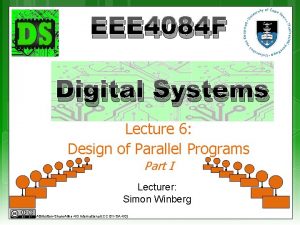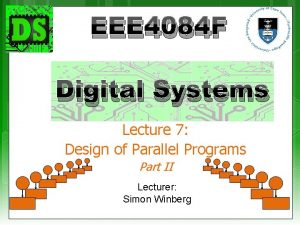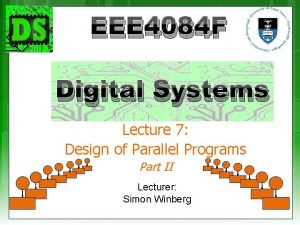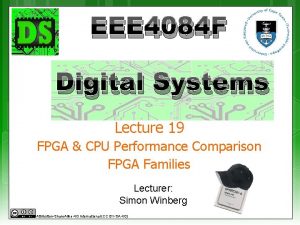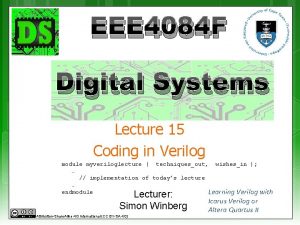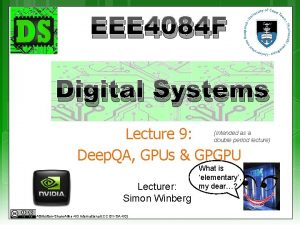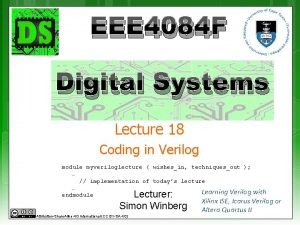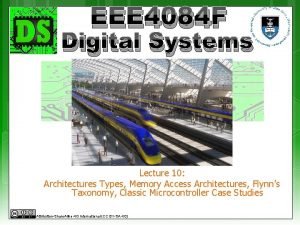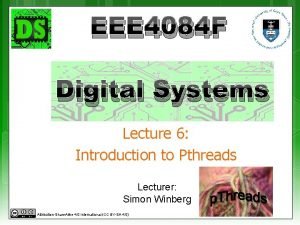EEE 4084 F Digital Systems Lecture 6 Design






















- Slides: 22

EEE 4084 F Digital Systems Lecture 6: Design of Parallel Programs Part I Lecturer: Simon Winberg Attribution-Share. Alike 4. 0 International (CC BY-SA 4. 0)

Lecture Overview Seminar this afternoon 3 pm Recap of memory architectures Steps in designing parallel programs Step 1: understanding the problem Step 2: partitioning Step 3: decomposition & granularity

Recap Memory Architectures EEE 4084 F The more detailed slides on memory architectures in the previous lectures was assigned as a reading task last week.

Brief recap of memory architectures Shared memory architecture Uniform access memory (UAM) vs. Non-uniform access memory (NAM) Distributed memory Similar to shared memory, but needs comms network to share memory (NB not always same as MPI) Distributed Best shared memory (hybrid) & worst of both ‘worlds’

Steps in Designing Parallel Programs …

nd a ong f l t ha ic o w e top s m o m e s a h r the on t prog g in trek llel t r a St uous para ard igning EEE 4084 F s e d Hardcore competent parallel programmers (leading the way to greater feats) Sequential programmers in their comfort zone. Steps in Designing Parallel Programs

this lecture Steps in designing parallel programs … The hardware may be done first… or later. The main steps: 1. Understand the problem 2. Partitioning (separation into main tasks) 3. Decomposition & Granularity 4. Communications 5. Identify data dependencies 6. Synchronization 7. Load balancing 8. Performance analysis and tuning

Step 1: Understanding the problem Make sure that you understand the problem, that is the right problem, before you attempt to formulate a solution (i. e. ‘problem validation’) Some problems aren’t suited to parallelization – it just might not be parallelizable Example of non-parallelizable problem: Calculating the set of Fibonacci series (e. g. , Fib(1020) as quickly as possible. Fib(n) = n } if n < 2 = Fib(n – 1) + Fib(n – 2) } otherwise

Step 1: Understanding the problem Many problems may have obvious parallel solutions. Others may need some concerted effort to discover the parallel nature. Easily parallel example: Given two tables, client (clientname, clientnum) and orders (clientnum, ordernum, date) find the name of clients who ordered something on 1 March 2010. Obvious solution: divide orders into smaller parts, each task checks the dates in its partition, it it matches the clientnum is added to a temporary list, at the end all the temporary lists are combined and clientnum replaced by clientname.

Step 1: Understanding the problem Identify: Critical parts or ‘hotspots’ Determine where most of the work needs to be done. Most scientific and technical programs accomplish the most substantial portion of the work in only a few small places. Focus on parallelizing hotspots. Ignore parts of the program that don’t need much CPU use. Consider which profiling techniques and performance analysis tools (‘PATs’) to use

Step 1: Understanding the problem Identify: Consider bottlenecks communication, I/O, memory and processing bottlenecks Determine areas of the code that execute notably slower than others. Add buffers / lists to avoid waiting Attempt to avoid blocking calls (e. g. , only block if the output buffer is full) Try to rearrange code to make loops faster

Step 1: Understanding the problem General identify method: hotspots, avoid unnecessary complication, identify potential inhibitors to the parallel design (e. g. , data dependencies). Consider other algorithms… This is an most important aspect of designing parallel applications. Sometimes the obvious method can be greatly improved upon though some lateral thought, and testing on paper.

Different perspectives: Gaining a better understand of the problem General Systems Thinking (GST) • How does the problem of focus relate to more general problems? • What other systems are being depended on or are affected? • Has a systems approach been considered in addition to the usual divide and simplify approach? See last page for suggested sites to learn more about critical analysis Critical Analysis (& Critical Thinking) Applying rational and logical thinking while deconstructing texts or subject matter studied. * • Let’s consider what happens, in a logical scientific / deductive manner, if we discard or replace some of the traditions or ‘conditioned choices’. • Reflecting on choices and descriptions • Considering ‘what if…’ scenarios (e. g. what if a chair had only one leg instead of four) * Adapted from: Browne, M & Keeley, S 2001, Asking the right questions: a guide to critical thinking, 6 th edn, Prentice-Hall, Upper Saddle River, N. J.

Step 2: Partitioning This step involves breaking the problem into separate chunks of work, which can then be implemented as multiple distributed tasks. Two typical methods to partition computation among parallel tasks: 1. 2. Functional decomposition or Domain decomposition

Functional decomposition focuses on the computation to be done, rather than the way data is separated and manipulated by tasks. The problem is decomposed into tasks according to the work that must be done. Each task performs a portion of the overall work. Tends to be closer to message passing and MIMD systems

Functional decomposition Task #2: 1. 2. 3. Task #1: 1. 2. 3. 4. m e l ob r P he Task #3: 1. 2. 3. 4. 5. T Task #4: 1. 2. Functional decomposition is suited to problems that can be split into different tasks

Functional decomposition Example applications Environment modelling Simulating reality Signal processing, e. g. : Pipelined filters: in P 1 P 2 P 3 out Here P 1 is filled first, its result is sent to P 2 while simultaneously P 1 starts working on a block of new input, and so on. Climate modelling (e. g. , simultaneously running simulations for atmosphere, land, and sea)

Domain decomposition Involves separating the data, or taking different ‘views’ of the same data. E. g. View 1 : looking at frequencies (e. g. FFTs) View 2 : looking at amplitudes Each parallel task works on its own portion of the data, or does something different with the same data The Data Task 1 Task 2 The Data Task 3 View 1 View 2 Task 1 Result Task 2 Result

Domain decomposition Good Data to use for problems where: is static (e. g. , factoring; matrix calculations) Dynamic data structures linked to a single entity (where entity can be made into subsets) (e. g. , multi-body problems) Domain is fixed, but computation within certain regions of the domain is dynamic (e. g. , fluid vortices models)

Domain decomposition Many possible ways to divide things up. If you want to look at it visually… continuous Blocked (samesize partitions) Interlaced Interleaved or cyclic Blocked Other methods can be done

Next lecture Practice example Continuation of the steps: Step 3 Granularity Class activity Step 4 Communications … Some resources related to critical analysis and critical thinking: An easy introduction to critical analysis: http: //www. deakin. edu. au/current-students/study-support/study-skills/handouts/critical-analysis. php An online quiz and learning tool for understanding critical thinking: http: //unilearning. uow. edu. au/critical/1 a. html

Disclaimers and copyright/licensing details I have tried to follow the correct practices concerning copyright and licensing of material, particularly image sources that have been used in this presentation. I have put much effort into trying to make this material open access so that it can be of benefit to others in their teaching and learning practice. Any mistakes or omissions with regards to these issues I will correct when notified. To the best of my understanding the material in these slides can be shared according to the Creative Commons “Attribution-Share. Alike 4. 0 International (CC BY-SA 4. 0)” license, and that is why I selected that license to apply to this presentation (it’s not because I particulate want my slides referenced but more to acknowledge the sources and generosity of others who have provided free material such as the images I have used). Image sources: Book clipart drawing - Wikipedia (open commons) Beach chairs, Himalayan Climbers - www. flickr. com (public domain) Picture of running going up stairs – Wikimedia open commons Sierpinski pyramid (slide 13) – Wikimedia open commons 3 -legged chair (slide 13) – Adapted (modification permitted) from Wikimedia
 Q6 4084
Q6 4084 01:640:244 lecture notes - lecture 15: plat, idah, farad
01:640:244 lecture notes - lecture 15: plat, idah, farad Digital systems testing and testable design
Digital systems testing and testable design Digital design: a systems approach
Digital design: a systems approach Digital design a system approach
Digital design a system approach Digital system design using verilog
Digital system design using verilog Eee kuet
Eee kuet Eee 360
Eee 360 Eee 322
Eee 322 Eee 121
Eee 121 Eee 431
Eee 431 Eee 302
Eee 302 Eee 302
Eee 302 Tahvel.edu.eee
Tahvel.edu.eee Eee 431
Eee 431 Eee 431
Eee 431 Eee 431
Eee 431 Eee 431
Eee 431 Eee 145
Eee 145 Lecc
Lecc Lempel-ziv coding in digital communication
Lempel-ziv coding in digital communication Eee 431
Eee 431 Eee 431
Eee 431
